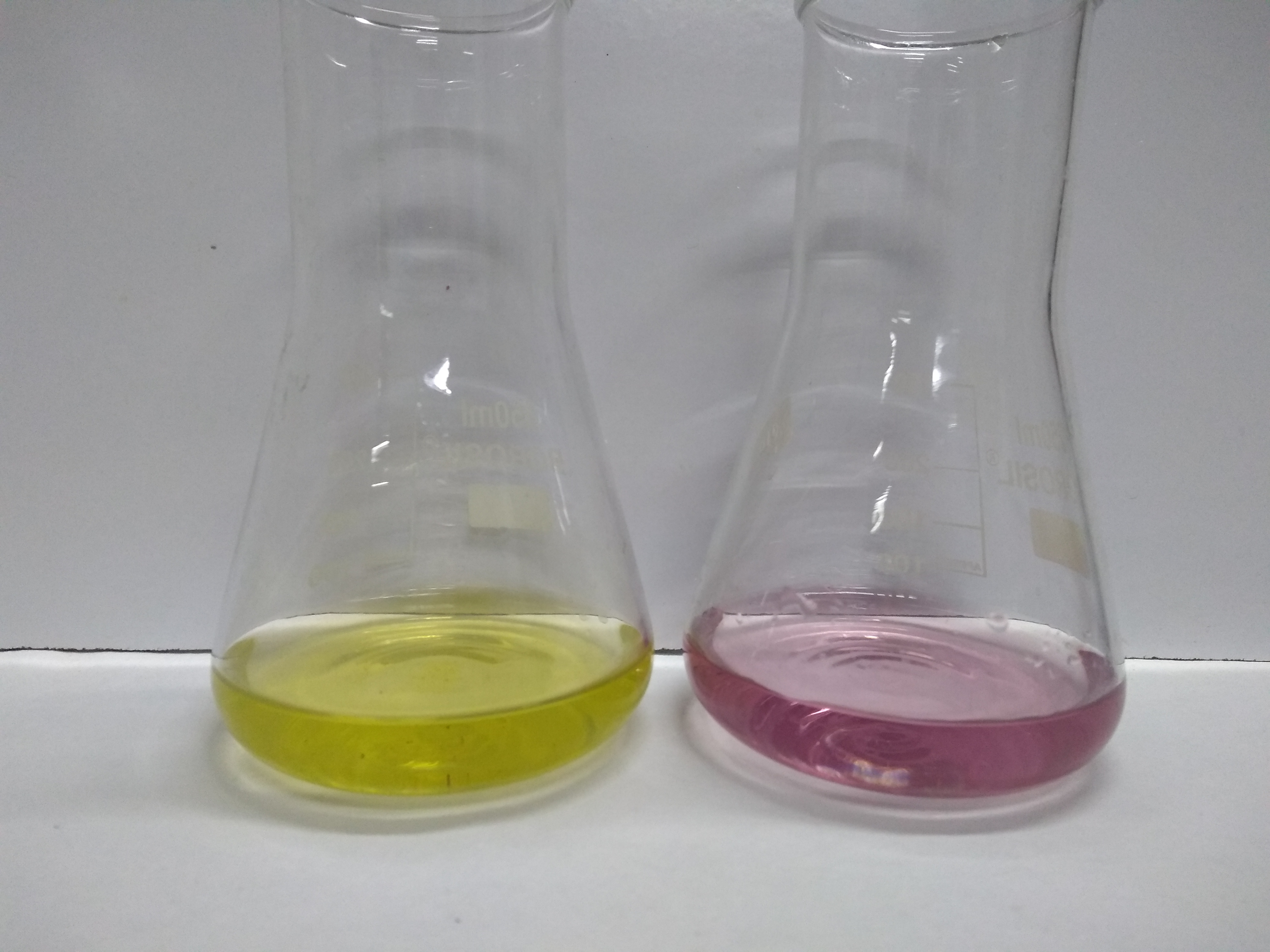Monel metal is an alloy of nickel and copper which is highly resistant to corrosion. It is commonly used in applications involving exposure to acids. In the current experiment, you are supplied with sample solution of Monel metal. You will be estimating the nickel and copper present in the sample by complexometric titration.
Pre-requisite (Theory)
- Students should be familiar with different principles involved in a complexometric titration
- EDTA and its equilibria
- Metallochromic indicators and their use in EDTA titration.
- Masking agents and their use in estimation of metal ions in a mixture
- pH, Buffers and their role in titration
- Stoichiometric equations calculations and role of formation constants in complexometric titrations.
Techniques/Skills involved
- Use of pipette bulb: Guide to use a Pipette aid
- Titration technique
- Preparation of solution in standard flask
Bibliography (Theory)
Jeffery, G.H., Bassett, J., Mendham, J., Denney, R.C., (1989). Vogel’s Textbook of Quantitative Chemical Analysis. John Wiley & Sons Inc, New York, 5th edition (309-322).
Skoog, D.A., West, D., Holler, F.J., (1995). Fundamental of Analytical Chemistry. Harcourt Asia PTE Ltd, Singapore, 7 edition, (400-422)
These textbooks presents the necessary discussions about general theory of complexometric titration including the role of various parameters such as pH, masking agents, metallochromic indicators etc.
https://chem.libretexts.org/Textbook_Maps/Analytical_Chemistry_Textbook_Maps/Map%3A_Analytical_Chemistry_2.0_(Harvey)/09_Titrimetric_Methods/9.3%3A_Complexation_Titrations (accessed on September 2017)
Glassware
| ▪ Burette (25 mL) | 2 |
| ▪ Beaker (100 mL) | 2 |
| ▪ Conical flasks (250 mL) | 4 |
| ▪ Funnel | 1 |
| ▪ Measuring cylinder (10 mL) | 1 |
| ▪ Measuring cylinder (25 ml) | 1 |
| ▪ Pipette 10 ml | 1 |
| ▪ Pipette bulb | 1 |
| ▪ Droppers | 3 |
| ▪ pH papers | 3 |
| ▪ Wash Bottle | 1 |
Chemicals
| ▪ Sample solution | 10 mL |
| ▪ Na2EDTA | 100 mL |
| ▪ Buffer pH 10 | 10 mL |
| ▪ 3M NaOH | |
| ▪ Conc. HCL | |
| ▪ 5% Na2S2O3 | |
| ▪ Murexide indicator |
Hazard Symbols
Corrosive to skin ![]()
Oxidizing ![]()
Toxic ![]()
Irritant ![]()
Harmful to environment ![]()
Flammable ![]()
Alloys of copper and nickel have been in use for a very long time. Despite its high copper content, cupronickel is silver in colour. Copper and nickel possess very specific properties and du to which they are also one of the highly valued metals. Because of their properties they are used in various domains of industry such as e.g. mint industry, armaments industry, marine engineering, and electrical industries.
Cupronickel alloy is very highly resistant to corrosion in seawater because its electrode potential is adjusted to be neutral with regard to seawater. Due to this fact, it is used for piping, heat exchangers and condensers in seawater systems etc.
In the current experiment, In Titration I you will determine the content of both the ions together whereas in Titration II you will determine the Ni content only.
The titrant used is Disodium salt of Ethylenediamine tetraacetic acid (abbreviation: Na2EDTA or Na2H2Y). Regardless of the charge on the metal ion, the titrant forms stable 1:1 complex with the metal ion.
The indicators used in the complexometric titrations are called as metal-ion indicators. They form stable complexes with the metal ions. The colour of the free indicator and that of the indictor- metal ion complex differ from each other.
Generally the pH is appropriately adjusted by using buffer solutions for the complexometric titration. In the current experiment the total ions are estimated at pH 10. By adding Na2S2O3 and adjusting the pH only Ni can be estimated. In presence of excess Na2S2O3, Cu (II) cannot form a complex with Na2EDTA.
The alloy sample can be opened by teacher and given to students in dissolved form in the standard flask
Procedure
Determination of the total ion content
- Dilute the given sample solution in your standard flask upto the mark with distilled water and shake it to homogenize it.
- Pipette 10 mL of the diluted solution in a 250 mL conical flask and add 30 mL of distilled water.
- With the help of the dropper, add buffer solution (pH 10) in a drop-wise manner to the flask. Keep shaking the solution during addition. Go on adding the buffer solution till your solution is cloudy and light blue in color. Continue the addition till the cloudiness just disappears.
- Now add the murexide indicator drop wise with swirling to get a yellowish green colored solution.
- Titrate with the given Na2EDTA solution till you get an orange colored solution. Now add Na2EDTA drop-wise until the color changes to violet with a single drop.
- You are allowed to take two more readings in similar manner. Enter your readings in the answer sheet.
Determination of the Ni content
- Pipette 10 mL of the given solution in a 250 mL conical flask and dilute it with 30 mL of water.
- Add 3 M NaOH dropwise until the solution becomes light cloudy and light blue in color. To this now add conc. HCl drop-wise so that the cloudiness just disappears.
- Now add 10 mL of the given 5 % Na2S2O3 and swirl the content. Then add buffer solution (pH 10) drop-wise until the solution pH is 8 (check with the pH paper). Swirl the content thoroughly.
- Add the murexide indicator drop- wise to get an orange yellow colored solution.
- Titrate the solution with the given Na2EDTA until the color changes to reddish pink with no tinge of orange left in the solution. Near the endpoint add Na2EDTA drop wise and observe the color against a white background.
- You are allowed to take two more readings in similar manner. Enter your readings in the answer sheet.
Concentration of Na2EDTA:…………………..M
| Titration I | Titration II | |||||
| Trial 1 |
Trial 2 |
Trial 3 |
Trial 1 |
Trial 2 |
Trial 3 |
|
| Initial burette reading (mL) | ||||||
| Final burette reading (mL) | ||||||
| Volume of Na2EDTA(mL) | ||||||
Questions
- Write the balanced chemical equations for the reactions of Cu (II) and Ni (II) with Na2EDTA. (Use the symbol Na2H2Y for Na2EDTA.)
- The reduction potential for Cu2+/Cu1+ is 0.15 V and that for S4O62–/S2O32– is 0.08 V. Explain whether Cu (II) will be reduced to Cu (I) by Na2S2O3?
- For any one trial, calculate the amount of Cu (II) and Ni (II) in grams in the total diluted sample solution. (Show the main steps in your calculation).
Amount of Copper (II) in grams for total diluted sample solution……………………
Amount of Ni (II) in grams for total diluted sample solution……………………
This video is shot in the chemistry laboratory of HBCSE and can be used for educational purposes
This video is shot in the chemistry laboratory of HBCSE and can be used for educational purposes




